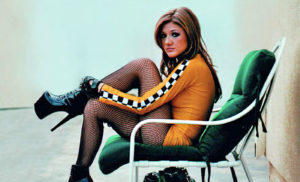I’m nine. I’m small for my age, but I’m strong. I climb trees. I make dens. I play out all day in the summer, and in the evening I sit in the bath and marvel at the way the scabs knit together on my knees and my bruises bloom and fade. I can’t describe my relationship with my body at this age, because for there to have been a relationship at all would suggest there were two of us, me and it, and there weren’t: there was just one happily animal thing.
I wasn’t a tomboy. I liked dresses, my long red hair, my collection of Sylvanians who lived soap-opera lives in neat plastic houses carefully arranged by me and my sister. But I knew there was something contemptible about the girlish things I enjoyed from the way the boys at school talked about them. Little by little, I learned to be ashamed of being the kind of person these things belonged to.
Then there were the unmistakable signs that me and my body would not, after all, enjoy our peaceful union forever: the adult women I overheard sociably griping about their own deficiencies (too fat, too big-bummed), the girls my age whose bodies were erupting into curves. The boys leered; the girls yet to start puberty judged. We whispered that the ones wearing bras were stuffing their cups with tissue paper, and said they rustled when they walked. I dreaded becoming one of them, and I feared what it would mean if it didn’t happen to me. One day — I suppose I was 10 — I stood at the corner of the playing field (which was, as usual, taken up by boys playing football) and thought I will not be a girl.
I got no say in the matter, though. My compact, reliable body sprouted embarrassing hair, turned to gooseflesh when boys (not even boys I liked!) looked at me, and exceeded its former bounds so rapidly I was striped with stretch marks all over my hips. We were two things now.
One day, I was dozing in the back of the car as my parents drove the family home and I heard a short story on the radio — I was almost 12 — about a man who wishes to be free of his body, so first cuts off his head, then has his brain removed from his skull. I would like to do that, I thought. To be pure self, no flesh at all. I was in the wrong body. It announced my femaleness, it invited certain ways of being looked at, sometimes touched. It betrayed me. I couldn’t dispose of it, so I hated it instead.
The metamorphosis of puberty is hard for almost everyone. For girls, though, there is a specific trauma. You don’t simply become an adult: you become a product on the sexual marketplace, regardless of your own will. This divides you: you learn to see yourself from the outside, as an object, through the imagined eyes of men. You lose your space in the world, and any part of you that goes beyond the strictly minimal can start to feel like grotesque excess.
Did I have dysphoria? There was no one to diagnose me; I only have my own memories to guide me. What I can say is that I don’t know of another word that describes my desire to discipline and punish myself into something safely un-sexed. When I read accounts from other female people describing their own dysphoria, I feel a painful recognition.
Trans man Lewis Hancox’s graphic novel Welcome to St Hell: My Trans Teen Misadventure has a diagram of Hancox’s teenage body, with the breasts marked “fatty lumps that need to be gone” and an arrow pointing to “hips from hell”. These are things I thought about myself. Not so severely as Hancox (I didn’t have an eating disorder), but I thought them.
If I had been offered a way out — a medical “pause button”, as hormone blockers are casually called — would I have taken it? I can’t think, actually, of anything I would have received more gratefully at this time in my life. Nor can I think of a more carelessly poisonous response than adults affirming what I felt about my body. It’s strange, then, that for 31 years, a specialist unit existed within the NHS which effectively took girls like me and told them: “yes, you’re right, your body is wrong, but we can fix that for you.” The unit was the Gender Identity Development Service (GIDS), contained within the Tavistock and Portman Trust in London. What happened there, and how it went so appallingly wrong, is now the subject of a remarkable book by the journalist Hannah Barnes called Time to Think.
GIDS didn’t only treat girls, but it’s the girls who particularly interest me. That’s partly because, as Barnes outlines, GIDS itself was remarkably uninterested in them. The service was founded by child and adolescent psychiatrist Domenico Di Ceglie in 1989, and initially, the patients had a clear profile: mostly boys, and usually referred in pre-pubescent childhood. Girls with dysphoria weren’t unheard of (the initial case that got Di Ceglie interested in gender identity was female), but they were not typical.
That changed dramatically. In 2011, GIDS saw for the first time an equal number of male and female patients. In 2020-21, 68% of the patients for whom GIDS recorded sex were female. (A repeated theme of the GIDS scandal is poor record keeping: shockingly, no birth sex was recorded for 22% of patients referred in 2021-22.) And these girls were arriving at the clinic older than the boys: pubescent adolescents who, like me, had no previous history of dysphoria.
But while they were strikingly unlike GIDS’s previous patients, these girls were astonishingly similar to each other. Barnes relates the description given by Anna Hutchinson, a senior clinical psychologist formerly employed at GIDS, and one of the many whistleblowers to have gone on the record about the service’s failings:
“Self-diagnosed adolescent trans boys — natal females — started to fill up GIDS’s waiting room with similar stories, haircuts, even names – ‘one after another after another’. They’d talk about their favourite trans YouTubers, many having adopted the same name, and how they aspired to be like them in the future.”
One thing that all GIDS patients had in common, regardless of sex, was that they had far more going on than just gender trouble. A 2012 study found that associated difficulties included “non-suicidal self-harm, suicidal ideation, suicide attempts, autism spectrum conditions (ASCs), attention deficit hyperactivity disorder (ADHD), symptoms of anxiety, psychosis, eating difficulties, bullying and abuse”.
Also, a lot of the girls presenting at GIDS were bisexual or lesbian — over 90%. Or rather, they would have been lesbian, if they’d identified as female. One clinician Barnes speaks to recalls female patients saying things like, “When I hear the word lesbian, I cringe. I want to die”, and “I’m gonna vomit if I hear the word lesbian another time”. Gay and lesbian clinicians who asked whether such internalised homophobia should complicate a dysphoria diagnosis were told that they were “too close” to the subject to be objective. That this dismissal of same-sex attracted people’s experiences and insights was itself a signal instance of homophobia seemed not to occur to GIDS as an institution.
GIDS, it seems, was no longer interested in asking questions. When the service was founded, one of its principles had been an explorative approach: “Di Ceglie could see that, in some cases, by addressing other difficulties experienced by the child — things like depression, abuse or trauma — it might ‘secondarily affect the gender identity development’. In other words, sometimes the gender identity difficulties might resolve if other difficulties being faced were dealt with as well.” But by the time the majority of GIDS’s caseload had become female adolescents, the culture of the service had decisively changed. In 2009, Polly Carmichael took over from Di Ceglie as head of the clinic. Her tenure saw the clinic adopt a high public profile — participating in a string of documentaries that boosted GIDS’s image and promoted its work — while internally adopting an “us against the world” attitude. Clinicians were encouraged to see themselves as a “family”: disagreement became a personal betrayal. One GIDS staff member recalls that anyone raising criticisms of the service was likely to be told “this has made Polly cry”.
Perhaps as important as the clinic’s leadership, though, were the external pressures: as the concept of “gender identity” took hold more widely, the idea that one’s “subconscious sex” ought to supersede the physical body began to direct treatment. Trans support groups like Mermaids and GIRES promoted an “affirmative model”, which insisted that any child who said they were trans should be treated as trans. This influenced both the expectations of patients and their families, and the practice of GIDS doctors. Hormone treatment became the default. Patients came, not because they wanted to explore their gender issues, but because they wanted puberty blockers. If doctors were unwilling to prescribe them, Barnes reports, patients would simply be referred to a different doctor. There was usually little opportunity for reflection: GIDS staff were expected to manage caseloads of up to 100 patients each, as referrals increased from 97 in 2009-10 to 2,748 in 2019-20 (a 2,800% increase overall, and an even more shocking 4,200% increase in girls). Once patients were on puberty blockers, nearly 100% would go on to take cross-sex hormones.
A service that had once prided itself on treating its patients as individuals had become something more like an assembly line. Whatever issues a child had, the only answer the clinic had was blockers. What’s terrible about this isn’t just that many children will have been put on a path to transition that could have been avoided; it’s that they were not receiving specialised support for their other, more pressing problems. Barnes tells the story of one boy who, as well as identifying as a girl, had such severe OCD that he couldn’t leave the house. His family got no support for the OCD, but GIDS sent a psychiatrist who offered to make an endocrinology referral.
With its one-size-fits-all plan, GIDS was failing every one of its patients: one of the reasons why, in 2022, an independent review commissioned by the NHS into gender identity services for children and young people made an interim recommendation that GIDS be shut down and replaced with regional specialist centres. (This spring, that advice will be enacted.) But — without diminishing the harm done to boys, which was plentiful — girls were particularly damaged by GIDS, because girls were being put on a pathway that was the definition of male default. GIDS had developed its approach to serve the traditional paediatric sufferer of dysphoria: a pre-pubertal boy. Because the clinic’s culture militated against self-reflection, the treatment stayed the same even though the patients had drastically changed.
It’s not uncommon for women to be badly served by medicine in this way, given that women are neglected as research subjects. Historically, femaleness has been treated as an abnormality, to be ignored if it cannot be remedied. What’s exceptional about the GIDS case, though, is that the underlying philosophy of trans identity effectively made these girls doubly invisible. They were invisible, firstly, to a model that had never taken them into account. But secondly, and more profoundly, they were invisible because gender identity doctrine held that even to think of them as female was to “misgender” them. You couldn’t say how they were different to boys without conceding that they were not, in strict fact, boys.
But to hate your body as a teenage girl is one of the most categorically female experiences possible. I didn’t hate my body because I wasn’t a girl; I hated it precisely because I was, and because of everything I feared or knew that being a woman might mean.
Trans activists tend to dismiss stories like mine: if I had truly been dysphoric, they say, I would never have grown up to be the basic bitch I am today. I would have found a way to transition. But if I’d had YouTube, Mermaids and a compliant medical service, the way would have been signposted for me in neon lights. I learned to live with my body, in time, because no one gave me an alternative.
One of the many reasons that the “pause button” claim about blockers is a lie is that going through puberty is one of the ways you become reconciled to puberty. Discovering your sexuality might help you discover that your body exists for your pleasure, not just external judgement. Gradually, the alien flesh can become familiar again. The girls who went through GIDS were denied this. Taking puberty blockers means you never reach adult sexual function. Tentative research suggests that girls who went on blockers actually felt worse about their bodies after several years. Blockers didn’t treat their dysphoria: they exacerbated it.
For some few, transition will have been the right outcome. Others are left forever learning to live with bodies that have been made strange and vulnerable — weakened bones, dropped voices, vaginal atrophy, scarred and breastless chests if they went on to have mastectomies. There is a small, but growing, community of female detransitioners. Barnes quotes one, who has undergone a double mastectomy and a hysterectomy: “I regret all of it… I wish someone would have been there to tell me not to get castrated at 21.”
The things these women did in an effort to become not-girls remind me so keenly of the girl I used to be, with her vague longing for a bodiless life. A perverse sisterhood of doomed escapologists, looking for a get-out from what biology had planned for us. The way I once felt about myself was terrible, but it was also normal: the terribly normal fact of feminine self-loathing. The tragedy of a misogynistic world is that it makes girls believe they need a cure for femaleness. The scandal of GIDS is that it pretended it could supply one.
Disclaimer
Some of the posts we share are controversial and we do not necessarily agree with them in the whole extend. Sometimes we agree with the content or part of it but we do not agree with the narration or language. Nevertheless we find them somehow interesting, valuable and/or informative or we share them, because we strongly believe in freedom of speech, free press and journalism. We strongly encourage you to have a critical approach to all the content, do your own research and analysis to build your own opinion.
We would be glad to have your feedback.
Source: UnHerd Read the original article here: https://unherd.com/






